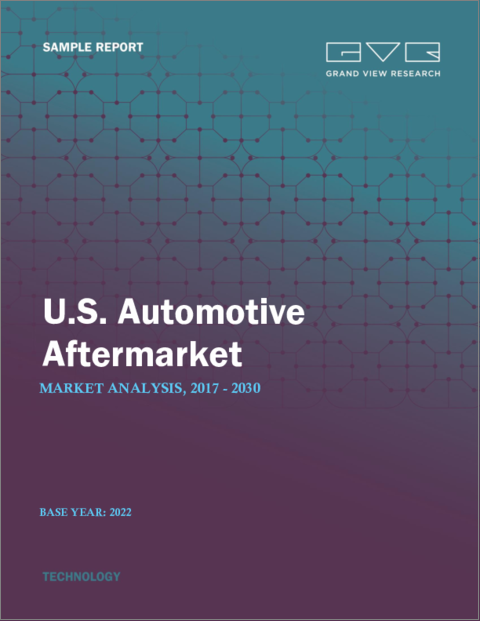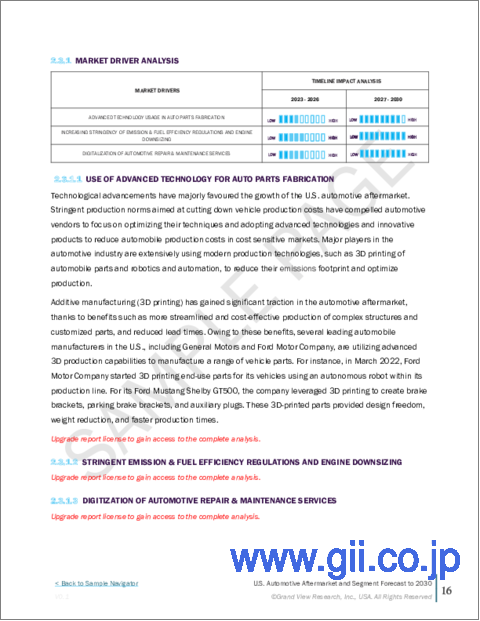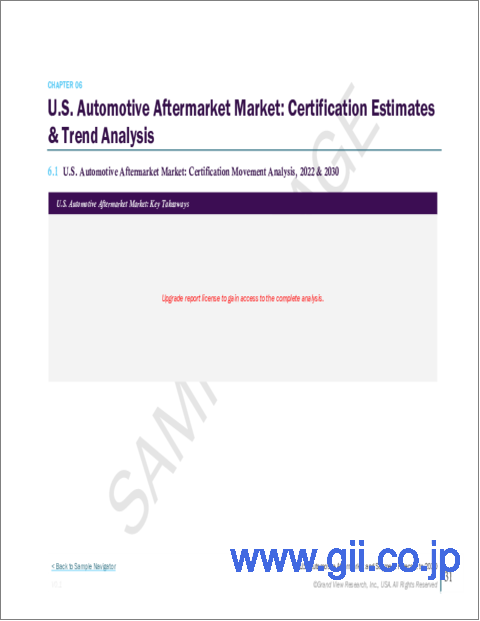|
|
市場調査レポート
商品コード
1321502
米国の自動車アフターマーケット産業規模・シェア・動向分析レポート:交換部品別、サービスチャネル別、認証別、製品価格別、流通チャネル別、セグメント予測、2023~2030年U.S. Automotive Aftermarket Industry Size, Share & Trends Analysis Report By Replacement Parts, By Service Channel, By Certification, By Product Pricing, By Distribution Channel, And Segment Forecasts, 2023 - 2030 |
||||||
カスタマイズ可能
|
|||||||
| 米国の自動車アフターマーケット産業規模・シェア・動向分析レポート:交換部品別、サービスチャネル別、認証別、製品価格別、流通チャネル別、セグメント予測、2023~2030年 |
|
出版日: 2023年07月24日
発行: Grand View Research
ページ情報: 英文 100 Pages
納期: 2~10営業日
|
- 全表示
- 概要
- 図表
- 目次
米国の自動車アフターマーケット産業の成長と動向
Grand View Research社の最新レポートによると、米国の自動車アフターマーケット産業規模は2030年までに2,819億8,000万米ドルに達する見込みです。同市場は、排気ガスや安全性など、自動車性能に影響を与える自動車技術の採用が増加していることから、2023年から2030年にかけてCAGR 4.1%で拡大すると予測されています。同市場は、自動車にコスト効率と軽量化をもたらす新しい化学物質や金属を導入することで、引き続きイノベーション主導で推移すると推定されます。加えて、米国では自動車保有台数と車齢が増加しているため、交換部品の需要が高まり、同国の市場成長を促進すると予想されます。米国における可処分所得の増加は、乗用車の販売に前向きな成長見通しを生み出しています。
補修用部品の需要増は、乗用車の販売増と正比例しています。さらに、インフラ整備や近代的なライフスタイルの普及といった要因も、自動車アフターマーケットの成長に寄与しています。技術の普及と自動車メーカーによる研究開発への高額の投資は、予測期間中、自動車アフターマーケット用部品の需要をさらに押し上げると予想されます。アフターマーケット製品を十分な量入手できるようにし、リサイクル製品の品質を向上させるためにベンダーが行っている努力が、エンジン、ドアアセンブリー、トランスミッション、フェンダー、トランクリッド、ボンネットなどの板金製品、バンパー、ライトアセンブリーなどの代替部品に対する高い需要につながっています。
加えて、高い在庫水準と幅広い流通網を維持することで、より高い充足率を実現し、代替部品の売上を押し上げています。しかし、ハイブリッド車や電気自動車の採用が増加していることが、自動車アフターマーケット部品(主に排気部品)の成長機会を妨げています。その結果、アフターマーケット部品の代替品の脅威は、予測期間中も高止まりすると予想されます。最近の自動車には、ADAS、インフォテインメント・システム、コネクティビティ機能などの先進技術が搭載されていることが多いです。こうした技術の自動車への統合が進むにつれて、専門的なアフターマーケット・サービスやソリューションの必要性が高まっています。このような先進システムのサービスに適応し、専門知識を提供できるアフターマーケット・プロバイダーは、成長にとって有利な立場にあります。デジタルチャネルやソーシャルメディアの影響力の高まりも、米国における自動車アフターパーツの販売に拍車をかけています。
米国の自動車アフターマーケット産業レポートハイライト
- タイヤ交換部品セグメントは、自動車部品と比較してタイヤの交換頻度が高いなどの要因により、2022年に22.52%のシェアで市場を独占しました。
- OEサービスチャネルは、その高い品質と信頼性により、2022年に55.91%のシェアを占めました。
- 自動車販売台数の増加、購買力の向上、生活水準の向上が業界の成長を牽引すると予想されます。
- 効率性と正確性を高め、職場の安全性を向上させ、人的ミスを減らすことから、市場はさまざまな機能やプロセスの自動化へとシフトしています。
目次
第1章 調査手法と範囲
- 市場セグメンテーションと範囲
- 市場の定義
- 情報調達
- 調査手法
- 調査範囲と前提条件
- データソースのリスト
第2章 エグゼクティブサマリー
第3章 米国の自動車アフターマーケット産業の市場変数と動向
- 市場系統の見通し
- 業界のバリューチェーン分析
- 米国の自動車アフターマーケット- サプライチェーン分析
- 市場力学
- 市場促進要因の影響分析
- 市場抑制要因の影響分析
- 業界の課題
- 業界の機会
- COVID-19のパンデミックの影響
- COVID-19の影響- 動向
- 2020年の新車販売台数
- 2020年の中古車販売台数
- 車の平均年齢
- DIYおよびDIM動向の台頭
- 米国の自動車アフターマーケットの消費者行動動向
- アナリストの推奨事項-米国の自動車アフターマーケット産業
- 小売業界のデジタル化
- 車両生成データへのアクセス
- デジタル仲介業者の影響によるバリューチェーンの強化:
- 業界分析ツール
- ポーターの分析
- マクロ経済分析
第4章 米国の自動車アフターマーケット産業:交換部品の推定・動向分析
- 交換部品の変動分析と市場シェア、2022年および2030年
- 交換部品別
- タイヤ
- バッテリー
- 空調部品
- オルタネーター/スターター
- ブレーキディスク/ドラム
- ブレーキパッド
- エアフィルター
- 燃料フィルター
- オイルフィルター
- 燃料ポンプ
- ウォーターポンプ
- ステアリングポンプ
- 点火プラグ
- ショックアブソーバー
- 体の部分
- 照明と電子部品
- ホイール
- 排気コンポーネント
- ターボチャージャー
- ワイパーコンポーネント
- その他
第5章 米国の自動車アフターマーケット産業:流通チャネルの推定・動向分析
- 流通チャネルの変動分析と市場シェア、2022年と2030年
- 流通チャネル別
- 小売業者
- 卸売業者および販売業者(W&D)
第6章 米国の自動車アフターマーケット産業:サービスチャネルの推定・動向分析
- サービスチャネルの変動分析と市場シェア、2022年と2030年
- サービスチャネル別
- DIY(Do It Yourself)
- DIFM(Do It For Me)
- OE(標準装備)
第7章 米国の自動車アフターマーケット産業:認証の推定・動向分析
- 認証変動分析と市場シェア、2022年と2030年
- 認証別
- 純正
- 認定部品
- 未認定部品
第8章 米国の自動車アフターマーケット産業:製品価格の推定・動向分析
- 製品価格変動分析と市場シェア、2022年と2030年
- 製品価格別
- 低コスト部品
- 中価格部品
- 高価な部品
第9章 米国の自動車アフターマーケット産業分析(交換部品別、製品価格別)
- タイヤ
- バッテリー
- 空調部品
- オルタネーター/スターター
- ブレーキディスク/ドラム
- ブレーキパッド
- エアフィルター(エンジンフィルターとキャビンフィルターの両方を含む)
- 燃料フィルター
- オイルフィルター
- 燃料ポンプ
- ウォーターポンプ
- ステアリングポンプ
- 点火プラグ
- ショックアブソーバー
- 体の部分
- 照明および電子部品(オルタネーター/スターターを除く)
- ホイール
- 排気コンポーネント
- ターボチャージャー
- ワイパー部品(ブレード、モーターを含む)
- その他
第10章 米国の自動車アフターマーケット産業- 競合情勢
- 主要市場参入企業による最近の動向と影響分析
- 企業の分類
- 参入企業の概要
- 財務実績
- 製品のベンチマーク
- 企業の市場での位置づけ
- 戦略マッピング
- 拡張
- 合併と買収
- パートナーシップとコラボレーション
- 新製品の発売
- その他
List of Tables
- Table 1 U.S. automotive aftermarket industry revenue estimates and forecast, by replacement parts, 2017 - 2030 (USD Billion)
- Table 2 U.S. automotive aftermarket industry revenue estimates and forecast, by distribution channel, 2017 - 2030 (USD Billion)
- Table 3 U.S. automotive aftermarket industry revenue estimates and forecast, by service channel, 2017 - 2030 (USD Billion)
- Table 4 U.S. automotive aftermarket industry revenue estimates and forecast, by certification, 2017 - 2030 (USD Billion)
- Table 5 U.S. automotive aftermarket industry revenue estimates and forecast, by product pricing, 2017 - 2030 (USD Billion)
- Table 6 Recent developments & impact analysis, by key market participants
- Table 7 Key companies undergoing expansions.
- Table 8 Key Companies involved in M&As
- Table 9 Key Companies undergoing collaborations.
- Table 10 Key Companies launching new products.
- Table 11 Key Companies undertaking other activities.
List of Figures
- Fig. 1 U.S. automotive aftermarket industry segmentation
- Fig. 2 Information procurement
- Fig. 3 Data analysis models
- Fig. 4 Market formulation and validation
- Fig. 5 Data validating & publishing
- Fig. 6 Market snapshot
- Fig. 7 Segment snapshot (1/3)
- Fig. 8 Segment snapshot (2/3)
- Fig. 9 Segment snapshot (3/3)
- Fig. 10 Competitive landscape snapshot
- Fig. 11 Automotive aftermarket value, 2022 (USD Billion)
- Fig. 12 U.S. automotive aftermarket industry - industry value chain analysis
- Fig. 13 Supply chain analysis
- Fig. 14 U.S. automotive aftermarket industry dynamics
- Fig. 15 U.S. automotive aftermarket industry: porter's analysis
- Fig. 16 U.S. automotive aftermarket industry: pestel analysis
- Fig. 17 U.S. automotive aftermarket industry, by replacement parts: key takeaways
- Fig. 18 U.S. automotive aftermarket industry, by replacement parts: market share, 2022 & 2030
- Fig. 19 Tire market estimates & forecasts, 2017 - 2030 (USD Billion)
- Fig. 20 Battery market estimates & forecasts, 2017 - 2030 (USD Billion)
- Fig. 21 Air conditioning parts market estimates & forecasts, 2017 - 2030 (USD Billion)
- Fig. 22 Alternator/Starter market estimates & forecasts, 2017 - 2030 (USD Billion)
- Fig. 23 Brake Disc/drum market estimates & forecasts, 2017 - 2030 (USD Billion)
- Fig. 24 Brake Pads market estimates & forecasts, 2017 - 2030 (USD Billion)
- Fig. 25 Air filters market estimates & forecasts, 2017 - 2030 (USD Billion)
- Fig. 26 Fuel filter market estimates & forecasts, 2017 - 2030 (USD Billion)
- Fig. 27 Oil Filter market estimates & forecasts, 2017 - 2030 (USD Billion)
- Fig. 28 Fuel pumps market estimates & forecasts, 2017 - 2030 (USD Billion)
- Fig. 29 Water pumps market estimates & forecasts, 2017 - 2030 (USD Billion)
- Fig. 30 Steering pumps market estimates & forecasts, 2017 - 2030 (USD Billion)
- Fig. 31 Spark plugs market estimates & forecasts, 2017 - 2030 (USD Billion)
- Fig. 32 Shock absorbers market estimates & forecasts, 2017 - 2030 (USD Billion)
- Fig. 33 Body parts market estimates & forecasts, 2017 - 2030 (USD Billion)
- Fig. 34 Lighting & electronic components market estimates & forecasts, 2017 - 2030 (USD Billion)
- Fig. 35 Wheels market estimates & forecasts, 2017 - 2030 (USD Billion)
- Fig. 36 Exhaust components market estimates & forecasts, 2017 - 2030 (USD Billion)
- Fig. 37 Turbochargers market estimates & forecasts, 2017 - 2030 (USD Billion)
- Fig. 38 Wiper components market estimates & forecasts, 2017 - 2030 (USD Billion)
- Fig. 39 Others market estimates & forecasts, 2017 - 2030 (USD Billion)
- Fig. 40 U.S. automotive aftermarket industry, by distribution channel: key takeaways
- Fig. 41 U.S. automotive aftermarket industry, by distribution channel: market share, 2022 & 2030
- Fig. 42 Retailers market estimates & forecasts, 2017 - 2030 (USD Billion)
- Fig. 43 Wholesalers and Distributors (W&D) market estimates & forecasts, 2017- 2030 (USD Billion)
- Fig. 44 U.S. automotive aftermarket industry, by service channel: Key Takeaways
- Fig. 45 U.S. automotive aftermarket industry, by service channel: market Share, 2022 & 2030
- Fig. 46 DIY (Do it Yourself) market estimates & forecasts, 2017 - 2030 (USD Billion)
- Fig. 47 DIFM (Do it for Me) market estimates & forecasts, 2017 - 2030 (USD Billion)
- Fig. 48 OE (Original Equipment) market estimates & forecasts, 2017 - 2030 (USD Billion)
- Fig. 49 U.S. automotive aftermarket industry, by certification: key takeaways
- Fig. 50 U.S. automotive aftermarket industry, by certification: market share, 2022 & 2030
- Fig. 51 Genuine market estimates & forecasts, 2017 - 2030 (USD Billion)
- Fig. 52 Certified parts market estimates & forecasts, 2017 - 2030 (USD Billion)
- Fig. 53 Uncertified parts market estimates & forecasts, 2017 - 2030 (USD Billion)
- Fig. 54 U.S. automotive aftermarket industry, by product pricing: Key Takeaways
- Fig. 55 U.S. automotive aftermarket industry, by product pricing: Market Share, 2022 & 2030
- Fig. 56 Low-Cost parts market estimates & forecasts, 2017 - 2030 (USD Billion)
- Fig. 57 Medium Cost parts market estimates & forecasts, 2017 - 2030 (USD Billion)
- Fig. 58 High-Cost parts market estimates & forecasts, 2017 - 2030 (USD Billion)
- Fig. 59 Tires market estimates & forecasts, by product pricing 2017 - 2030 (USD Billion)
- Fig. 60 Battery market estimates & forecasts, by product pricing 2017 - 2030 (USD Billion)
- Fig. 61 Air conditioning parts market estimates & forecasts, by product pricing 2017 - 2030 (USD Billion)
- Fig. 62 Alternator/Starter market estimates & forecasts, by product pricing 2017 - 2030 (USD Billion)
- Fig. 63 Brake Disc/Drum market estimates & forecasts, by product pricing 2017 - 2030 (USD Billion)
- Fig. 64 Brake Pads market estimates & forecasts, by product pricing 2017 - 2030 (USD Billion)
- Fig. 65 Air Filters market estimates & forecasts, by product pricing 2017 - 2030 (USD Billion)
- Fig. 66 Fuel Filter market estimates & forecasts, by product pricing 2017 - 2030 (USD Billion)
- Fig. 67 Oil Filter market estimates & forecasts, by product pricing 2017 - 2030 (USD Billion)
- Fig. 68 Fuel Pumps market estimates & forecasts, by product pricing 2017 - 2030 (USD Billion)
- Fig. 69 Water Pumps market estimates & forecasts, by product pricing 2017 - 2030 (USD Billion)
- Fig. 70 Steering Pumps market estimates & forecasts, by product pricing 2017 - 2030 (USD Billion)
- Fig. 71 Spark Plugs market estimates & forecasts, by product pricing 2017 - 2030 (USD Billion)
- Fig. 72 Shock Absorbers market estimates & forecasts, by product pricing 2017 - 2030 (USD Billion)
- Fig. 73 Body parts market estimates & forecasts, by product pricing 2017 - 2030 (USD Billion)
- Fig. 74 Lighting & Electronic components market estimates & forecasts, by product pricing 2017 - 2030 (USD Billion)
- Fig. 75 Wheels market estimates & forecasts, by product pricing 2017 - 2030 (USD Billion)
- Fig. 76 Exhaust components market estimates & forecasts, by product pricing 2017 - 2030 (USD Billion)
- Fig. 77 Turbochargers market estimates & forecasts, by product pricing 2017 - 2030 (USD Billion)
- Fig. 78 Wiper components market estimates & forecasts, by product pricing 2017 - 2030 (USD Billion)
- Fig. 79 Others market estimates & forecasts, by product pricing 2017 - 2030 (USD Billion)
- Fig. 80 Key company categorization
- Fig. 81 Company market positioning
- Fig. 82 Strategic framework
U.S. Automotive Aftermarket Industry Growth & Trends
The U.S. automotive aftermarket industry size is expected to reach USD 281.98 billion by 2030, according to a new report by Grand View Research, Inc. The market is anticipated to expand at a CAGR of 4.1% from 2023 to 2030 owing to the rising adoption of automotive technologies, such as exhaust and safety and other aspects influencing vehicular performance. The market is estimated to remain innovation-led by introducing new chemicals and metals that provide cost-efficiency and weight reduction in automobiles. In addition, the increasing vehicle parc and vehicle age in the U.S. is expected to contribute to the growing demand for replacement parts, thus driving market growth in the country. Rising disposable income in the U.S. is creating a positive growth outlook for the sales of passenger cars.
The increasing demand for aftermarket parts is directly proportional to the growing sales of passenger cars. Moreover, factors, such as developing infrastructure and increasing adoption of modern lifestyle across the country contribute to the growth of automotive aftermarket. Technological proliferation and high investments in R&D by automakers are expected to further drive demand for automotive aftermarket components over the forecast period. Efforts taken by vendors to make aftermarket products available in adequate quantities and improve the quality of recycled products have contributed to the high demand for alternative parts, such as engines; door assemblies; transmissions; sheet metal products, such as fenders, trunk lids, and hoods; bumpers; and lights assemblies.
In addition, maintaining a high inventory level and wide distribution network allows higher fulfillment rates, boosting the sales of alternative parts. However, the increasing adoption of hybrid and electric vehicles is hampering the growth opportunities for automotive aftermarket components, mainly exhaust components. As a result, the threat of substitutes for aftermarket parts is expected to remain high over the forecast period. Modern vehicles often have advanced technologies, such as ADAS, infotainment systems, and connectivity features. The rising integration of these technologies in vehicles creates the need for specialized aftermarket services and solutions. Aftermarket providers that can adapt and provide expertise in servicing these advanced systems are well-positioned for growth. The rise of digital channels or social media influence is also fueling the sale of automotive afterparts in the U.S.
U.S. Automotive Aftermarket Industry Report Highlights
- The tire replacement part segment dominated the market with a share of 22.52% in 2022 due to the factors, such as frequent replacements of tires compared to their automotive component counterparts
- The OE service channel segment dominated the market with a share of 55.91% in 2022 on account of their high quality and reliability
- The rise in sales of automobiles, increased purchasing power, and improved standard of living are expected to drive the industry growth
- The market is shifting toward the automation of various functions and processes as it enhances efficiency & accuracy, improves workplace safety, and reduces human errors
Table of Contents
Chapter 1 Methodology And Scope
- 1.1 Market Segmentation & Scope
- 1.2 Market Definitions
- 1.3 Information Procurement
- 1.3.1 Information Analysis
- 1.3.2 Market Formulation & Data Visualization
- 1.3.3 Data Validation & Publishing
- 1.4 Research Methodology
- 1.5 Research Scope And Assumptions
- 1.6 List Of Data Sources
- 1.6.1 Secondary Sources
- 1.6.2 Primary Sources
Chapter 2 Executive Summary
- 2.1 Market Snapshot
- 2.2 Segment Snapshot
- 2.3 Competitive Landscape Snapshot
Chapter 3 U.S. Automotive Aftermarket Industry Market Variables And Trends
- 3.1 Market Lineage Outlook
- 3.2 Industry Value Chain Analysis
- 3.2.1 U.S Automotive Aftermarket - Supply Chain Analysis
- 3.2.1.1 Components Of U.S. Automotive Aftermarket Industry
- 3.2.1.2 Manufacturing & Technology Trends
- 3.2.1 U.S Automotive Aftermarket - Supply Chain Analysis
- 3.3 Market Dynamics
- 3.3.1 Market Driver Impact Analysis
- 3.3.1.1 Use Of Advanced Technology For Auto Parts Fabrication
- 3.3.1.2 Stringent Emission & Fuel Efficiency Regulations And Engine Downsizing
- 3.3.1.3 Digitization Of Automotive Repair & Maintenance Services
- 3.3.2 Market Restraint Impact Analysis
- 3.3.2.1 Counterfeiting Of Auto Components
- 3.3.2.2 Implementation Of Various Safety Systems For Motor Vehicles
- 3.3.3 Industry Challenges
- 3.3.4 Industry Opportunities
- 3.3.1 Market Driver Impact Analysis
- 3.4 Impact Of The COVID-19 Pandemic
- 3.5 COVID-19 Impact - Trends
- 3.5.1 Sales Of New Cars In 2020
- 3.5.2 Sales Of Used Cars In 2020
- 3.5.3 Average Age Of The Car
- 3.5.4 A Rise In The Diy And Difm Trends
- 3.6 Automotive Aftermarket Consumer Behavior Trends In U.S.
- 3.7 Analyst Recommendations - U.S. Automotive Aftermarket Industry
- 3.7.1 Digitalization In Retail Industry
- 3.7.2 Access To Vehicle-Generated Data
- 3.7.3 Enhancement In Value Chain By Influence Of Digital Intermediaries:
- 3.8 Industry Analysis Tools
- 3.8.1 Porter's Analysis
- 3.8.2 Macroeconomic Analysis
Chapter 4 U.S. Automotive Aftermarket Industry: Replacement Parts Estimates & Trend Analysis
- 4.1 Replacement Parts Movement Analysis & Market Share, 2022 & 2030
- 4.2 U.S. Automotive Aftermarket Industry Estimates & Forecast, By Replacement Parts
- 4.2.1 Tire
- 4.2.2 Battery
- 4.2.3 Air Conditioning Parts
- 4.2.4 Alternator/Starter
- 4.2.5 Brake Disc/Drum
- 4.2.6 Brake Pads
- 4.2.7 Air Filters
- 4.2.8 Fuel Filter
- 4.2.9 Oil Filter
- 4.2.10 Fuel Pumps
- 4.2.11 Water Pumps
- 4.2.12 Steering Pumps
- 4.2.13 Spark Plugs
- 4.2.14 Shock Absorbers
- 4.2.15 Body Parts
- 4.2.16 Lighting & Electronic Components
- 4.2.17 Wheels
- 4.2.18 Exhaust Components
- 4.2.19 Turbochargers
- 4.2.20 Wiper Components
- 4.2.21 Others
Chapter 5 U.S. Automotive Aftermarket Industry: Distribution Channel Estimates & Trend Analysis
- 5.1 Distribution Channel Movement Analysis & Market Share, 2022 & 2030
- 5.2 U.S. Automotive Aftermarket Industry Estimates & Forecast, By Distribution Channel
- 5.2.1 Retailers
- 5.2.2 Wholesalers And Distributors (W&D)
Chapter 6 U.S. Automotive Aftermarket Industry: Service Channel Estimates & Trend Analysis
- 6.1 Service Channel Movement Analysis & Market Share, 2022 & 2030
- 6.2 U.S. Automotive Aftermarket Industry Estimates & Forecast, By Service Channel
- 6.2.1 DIY (Do It Yourself)
- 6.2.2 DIFM (Do It For Me)
- 6.2.3 OE (Original Equipment)
Chapter 7 U.S. Automotive Aftermarket Industry: Certification Estimates & Trend Analysis
- 7.1 Certification Movement Analysis & Market Share, 2022 & 2030
- 7.2 U.S. Automotive Aftermarket Industry Estimates & Forecast, By Certification
- 7.2.1 Genuine
- 7.2.2 Certified Parts
- 7.2.3 Uncertified Parts
Chapter 8 U.S. Automotive Aftermarket Industry: Product Pricing Estimates & Trend Analysis
- 8.1 Product Pricing Movement Analysis & Market Share, 2022 & 2030
- 8.2 U.S. Automotive Aftermarket Industry Estimates & Forecast, By Product Pricing
- 8.2.1 Low-Cost Parts
- 8.2.2 Medium-Cost Parts
- 8.2.3 High-Cost Parts
Chapter 9 U.S. Automotive Aftermarket Industry Analysis, By Replacement Parts, By Product Pricing
- 9.1 Tires
- 9.2 Battery
- 9.3 Air Conditioning Parts
- 9.4 Alternator/Starter
- 9.5 Brake Disc/Drum
- 9.6 Brake Pads
- 9.7 Air Filters (Including Both Engine And Cabin Filters)
- 9.8 Fuel Filter
- 9.9 Oil Filter
- 9.10 Fuel Pumps
- 9.11 Water Pumps
- 9.12 Steering Pumps
- 9.13 Spark Plugs
- 9.14 Shock Absorbers
- 9.15 Body Parts
- 9.16 Lighting & Electronic Components (Excluding Alternator/Starter)
- 9.17 Wheels
- 9.18 Exhaust Components
- 9.19 Turbochargers
- 9.20 Wiper Components (Including Blades, Motor)
- 9.21 Others
Chapter 10 U.S. Automotive Aftermarket Industry - Competitive Landscape
- 10.1 Recent Developments & Impact Analysis, By Key Market Participants
- 10.2 Company Categorization
- 10.3 Participant's Overview
- 10.4 Financial Performance
- 10.5 Product Benchmarking
- 10.6 Company Market Positioning
- 10.7 Strategy Mapping
- 10.7.1 Expansion
- 10.7.2 Mergers & Acquisition
- 10.7.3 Partenerships & Collaborations
- 10.7.4 New Product Launches
- 10.7.5 Other





